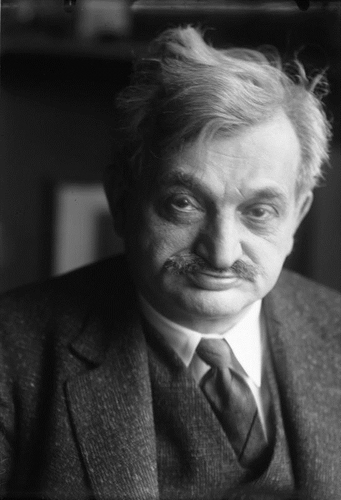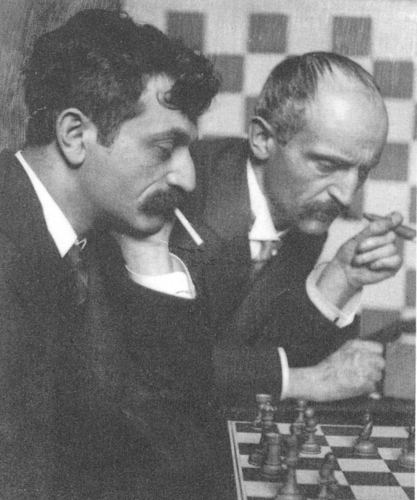A sampling of victories by Emanuel Lasker, the "psychological" master who held the world chess championship for 27 years.
Heinrich Fraenkel, who wrote a popular chess column in Great Britain under the pseudonym “Assiac,” remarked that Emanuel Lasker “at all times played the man rather than the board.” Lasker held the world chess championship title longer than anyone else (1894-1921).

Lasker was a mathematician and philosopher who firmly believed in employing psychology in chess (and in warfare). Fraenkel wrote in his book The Delights of Chess: “He would adapt his game with uncanny insight and precision to the personality and the present mood of his opponent and the circumstances of that particular game.”
Psychology or no, Lasker added his share of memorable games to the body of chess scholarship. Here are three examples.
Before Lasker Became the World Chess Champion. . . .
He played this 1893 match game in Havana against Celso Golmayo, a Cuban lawyer and chess master. Golmayo was 73 years old but still a fierce board competitor; Lasker was 24 and just a year away from his title victory against Wilhelm Steinitz. Here, Lasker played White.

Sicilian Defense
1) P-K4, P-QB4; 2) Kt-KB3, P-KKt3; 3) P-Q4, PxP; 4) KtxP, B-Kt2; 5) Kt-QB3, Kt-QB3; 6) B-K3, Kt-B3; 7) B-K2, O-O; 8) P-B4, P-Q3; 9) O-O, Kt-KKt5; 10) BxKt, BxKt; 11) QBxB, BxB; 12) Q-Q2, B-K3; 13) P-B5, B-B5; 14) R-B3, KtxB; 15) QxKt, B-R3; 16) Kt-Q5, R-B1; 17) P-B6, R-B5; 18) Q-Q2, PxP; 19) Q-R6, P-B4; 20) R-KR3, resigns.
An “Immortal” Chess Battle
Lasker won this game against grandmaster Richard Réti in a 1924 New York tournament—three years after Lasker lost the world chess title. Chess historian/author I.A. Horowitz called it “one of the immortal games of chess history.” Lasker played Black.
Réti Opening
1) Kt-KB3, P-Q4; 2) P-B4, P-QB3; 3) P-QN3, B-B4; 4) P-Kt3, Kt-B3; 5) B-KKt2, QKt-Q2; 6) B-Kt2, P-K3; 7) O-O, B-Q3; 8) P-Q3, O-O; 9) QKt-Q2, P-K4; 10) PxP, PxP; 11) R-B1, Q-K2; 12) R-B2, P-QR4; 13) P-QR4, P-R3; 14) Q-R1, KR-K1; 15) KR-B1, B-R2; 16) Kt-B1, Kt-B4; 17) RxKt, BxR; 18) KtxP, QR-B1; 19) Kt-K3, Q-K3; 20) P-R3, B-Q3; 21) RxR, RxR; 22) Kt-B3, B-K2; 23) Kt-Q4, Q-Q2; 24) K-R2, P-R4; 25) Q-R1, P-R5; 26) KtxP, PxPch; 27) PxP, KtxKt; 28) BxKt, B-B3; 29) BxKtP, R-B4; 30) B-R6, B-Kt3; 31) Q-Kt7, Q-Q1; 32) P-QKt4, R-B2; 33) Q-Kt6, R-Q2; 34) QxQch, RxQ; 35) P-K3, PxP; 36) K-Kt2, BxKt; 37) PxB, B-B4; 38) B-Kt7, B-K3; 39) K-B3, B-Kt6; 40) B-B6, R-Q3; 41) B-Kt5, R-B3ch; 42) K-K3, R-K3ch; 43) K-B4, R-K7; 44) B-B1, R-QB7; 45) B-K3, B-Q4; 46) resigns. (White can’t prevent Black from queening a pawn, and can’t queen its own queen’s rook pawn.)
Lasker Makes an Opponent Proud
Fraenkel observed that this game was one of Lasker’s own favorites. More remarkably, it became the favorite of his defeated opponent, 22-year-old William E. Napier. They faced off at an international chess tournament in Cambridge Springs, Pennsylvania, in 1904. Napier later asserted he was prouder of this loss than of any game he won. Lasker played White.
Sicilian Defense
1) P-K4, P-QB4; 2) Kt-QB3, Kt-QB3; 3) Kt-B3, P-KNt3; 4) P-Q4, PxP; 5) KtxP, B-Kt2; 6) B-K3, P-Q3; 7) P-KR3, Kt-B3; 8) P-KKt4, O-O; 9) P-Kt5, Kt-K1; 10) P-KR4, Kt-B2; 11) P-B4, P-K4; 12) KKt-K2, P-Q4; 13) KPxP, Kt-Q5; 14) KtxKt, KtxP; 15) Kt-B5, KtxKt; 16) QxQ, RxQ; 17) Kt-K7ch, K-R1; 18) P-R5, R-K1; 19) B-B5, KtPxP; 20) B-B4, PxP; 21) BxBP, Kt-K5; 22) BxR, BxP; 23) QR-Kt1, B-B6ch; 24) K-B1, B-KKt5; 25) KBxP, BxB; 26) RxB, Kt-Kt6ch; 27) K-Kt2, KtxR; 28) RxP, P-R4; 29) R-Kt3, B-Kt2; 30) R-KR3, Kt-Kt6; 31) K-B3, R-R3; 32) KxP, Kt-K7ch; 33) K-B5, Kt-B6; 34) P-R3, Kt-R5; 35) B-K3, resigns.
SOURCES:
“Assiac” (Heinrich Fraenkel). The Delights of Chess. A.S. Barnes and Company, Inc. (1961).
Horowitz, I.A. The Golden Treasury of Chess. Cornerstone Library (1974).
“Cambridge Springs, 1904.” Chess.com.
Horton, Byrne J. Dictionary of Modern Chess. Philosophical Library (1959).
Reinfeld, Fred. Great Short Games of the Chess Masters. Collier Books (1961).
Comments